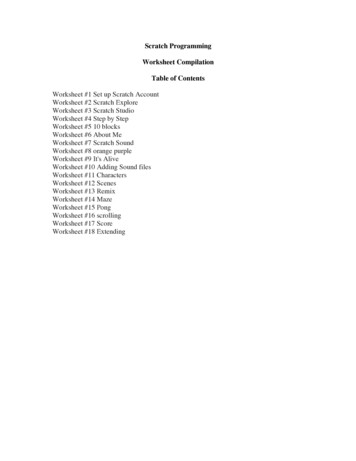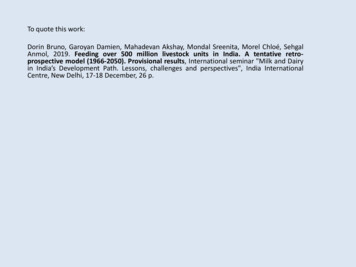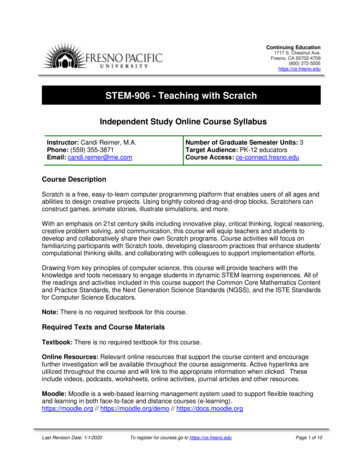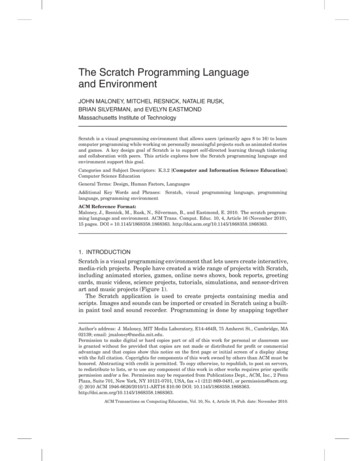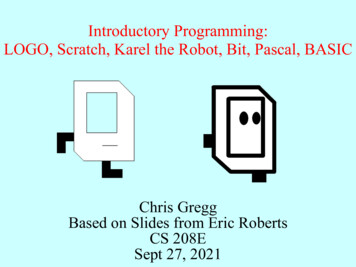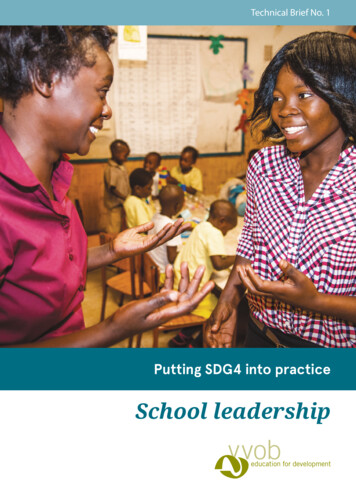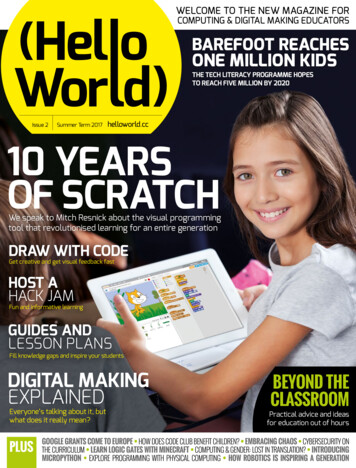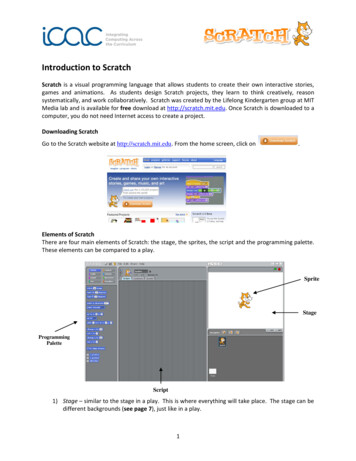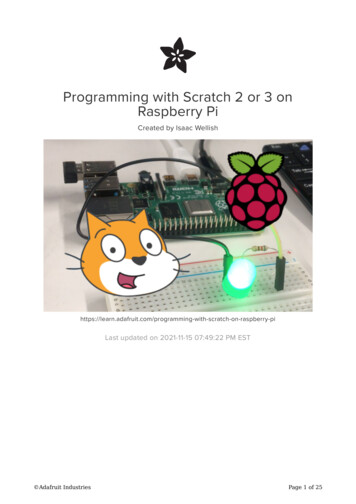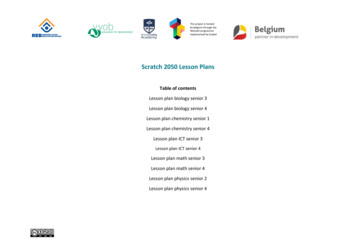
Transcription
This project is fundedby Belgium through theWehubit programmeimplemented by EnabelScratch 2050 Lesson PlansTable of contentsLesson plan biology senior 3Lesson plan biology senior 4Lesson plan chemistry senior 1Lesson plan chemistry senior 4Lesson plan ICT senior 3Lesson plan ICT senior 4Lesson plan math senior 3Lesson plan math senior 4Lesson plan physics senior 2Lesson plan physics senior 4
LESSON PLAN Biology Senior 3TermIDateSubject21/102020 BiologyClassS3Type of special Educational Needs to be catered for inthis lesson and number of learners in each categoryUnit titleKey UnitcompetenceTitle of thelessonInstructionalobjectivePlan for r alllearners)ReferencesUnitInterdependence among organismsin an ecosystem.No special education needLessonPredationDuration40minutsClass Size15Interdependence among organisms in an ecosystem.To be able to classify examples of species interactions.Predation (hunting animal (prey), animal (predator).Identify features that allow a predator to kill and feed on its preyInside class roomComputer, flip charts, chalk board and internete-source, biology for s3 students book.Timing for each stepDescription of teaching and learning activities:Having the different examples of common prays and predators both domesticand wild, aquatic and terrestrial, learners by themselves classify them intogroups and appreciate their existence on the earth and their importance tohuman life.Teacher activitiesLearner activitiesGeneric competences and Cross cutting issuesto be addressed a short explanation
This project is fundedby Belgium through theWehubit programmeimplemented by EnabelIntroduction(5minuts)Engage phaseWith the chats of different organismsAsk the learners to give examplesorganisms from the flip chart.-The learners will observe and theywill answer questions from teacherby stating organisms seen from theflip chart.Critical thinking,brainstorming,cooperation,communication skills, problemsolvingLearner centered learning utilizingICT with 4E(Exposure, Enjoy, Engage,Evaluate)(a)Gender education: Duringforming the groups, we based onthe number of boys and girls inthe classDevelopment of thelesson (30 minutes)(b)Explore phases- Students are organized into five groupand they are observing in front of themthe flip chart-learners are given chance to state anddefine the major terms- Teacher will develop scratch animationto facilitate learners to explore thecontent-The learners are given the piece ofpaper where it is drawn a table to use forgroupingPreyPredator-The learners go to their groups andchoose the secretaries and timekeepers of the group- they understand carefullyinstructions from teacher and worktogether in order to achieve to goodresults.Major terms:Predator: isan animal that lives by killing andeating other animals :-The learners, guided by teacher aregoing towork out the activity given by theteacher(b) Peace education: acknowledging ourdifferences and be the importance of livingtogether(c) Inclusive education: to payattention to all learners in theclass, based on their ability oflearning(d) Environmental education differentorganism are important in ecosystemto environment
(d) Elaborate phaseI ask the learners to observe theanimation from scratch.-support the groups and help themwhere possible-Ask learners to note what they haveobserved-Using the blackboard, ask the learnersto present their findings(c) Explain phase-In their groups, learners, referringto the above activity, are going to giveadaptation of each group in common- I ask them to present their findings andare noted on the blackboard.Conclusion (5minuts)Teacher self-evaluationEvaluate phaseI ask learners to play the scratch GAME,and ask them to answer individuallyPREYSCow, goat, pig,hen , buffalo,zebra.PredatorsDog, cat, lion,leopard-The learners in their group, carryout thesimple experiment in their groupAnd note their observationsThey present their findings on theblack boardThe learners watch video, providedin scratch gamesThe learners with their machinesconnected tothe network ,start a scratch projectshowing predation process
This project is fundedby Belgium through theWehubit programmeimplemented by EnabelLESSON PLAN Biology Senior ass Size1/540minuts1514Type of special Educational Needs to be catered for inthis lesson and number of learners in each categoryNo special education needUnit titleSupport And LocomotionKey UnitcompetenceExplain and demonstrate modes of locomotion in protists, insects, fish, amphibians, birds and mammalsTitle of thelessonSupport and locomotion in terrestrial animalsInstructional Observe and explain the relationship between muscles, joints and musculoskeletal attachments, amphibians, and mammals.objectivePlan for thisClass(location:in/outside)Inside and outside classroomLearningMaterialsComputer, flip charts, chalk board and internet, and scratch animation on locomotion of common terrestrial animals.
(For alllearners)Referencese-source, biology for s4 students book.Timing for each stepDescription of teach and learning activityHaving the different examples terrestrial, learners by themselves classify theminto groups and appreciate their ways of locomotionTeacher activitiesLearner activitiesIntroductionEngage phase(5minuts)With the chats of different organisms-The learners will observe, and theywill answer questions from theteacher by stating organisms seenfrom the flip chart. (man, cow, dogsnake and earthworm)Ask the learners to give examplesorganisms from the flip chart.Generic competences andCross cutting issues to beaddressed a shortexplanationCritical thinking,brainstorming,cooperation,communication skills,problemsolvingLearner centered learningutilizingICT with 4E(Exposure, Enjoy, Engage,Evaluate)(a)Gender education: During
This project is fundedby Belgium through theWehubit programmeimplemented by Enabelforming the groups, webased onthe number of boys and girlsinthe classDevelopment of thelesson (30 minutes)(b)Explore phases- Students are organized into five groupsand they are observing on the flip chart-learners are given chance to state anddefine the major terms- Teachers demonstrate scratchanimation on locomotion of commonterrestrial animals to facilitate learners toexplore the content.-The learners are given a chance to statedifferent types of locomotion dependingon the mammals given on chat.a) manb) frogc) dog-The learners go to their groups andchoose the secretaries and timekeepers of the group- They understand instructionscarefully from the teacher and worktogether in order to achieve goodresults.Major terms:. locomotion :movement oforganisms from one place toanothermovement: moving part oforganism’s bodyextensor : muscle that increases theangle between member of a limb.(b) Peace education:acknowledging ourdifferences and theimportance of livingtogether and diversity.(c) Inclusive education: topay attention to all learnersin the class, based on theirability of learning(d) Environmental educationdifferent organism areimportant in ecosystemto environment
d) earthworms(d) Elaborate phaseflexor: this is the muscle that flexesa joint.I ask the learners to observe the videostudents state the type locomotionindownloaded from youtube that showslocomotion in different terrestrialanimalsAnimallocomotionmanwalk-Using the blackboard, ask the learnersfrogjumpingto present their findingsearthwormcrawling-I ask the learners to note what they haveobserved(c) Explain phase-In their groups, learners, referringto the above activity, are going to giveadaptation of each group in common- I ask them to present their findings and-The learners in their group, carryout the simple experiment in theirgroup, And note their observationsThey present their findings on theblack boardare noted on the blackboard.The learners watch video, providedin scratch animation.Conclusion (5minuts)Evaluate phaseI ask learners to play the scratch GAME,and ask them to answer individuallyThe learners with their machinesconnected tothe network ,start a scratch projectshowing locomotion in human
This project is fundedby Belgium through theWehubit programmeimplemented by EnabelTeacher self-evaluationLesson plan chemistry senior 1School Name:TermTeacher’s Name:DateSubjectClassUnit NoLesson NoDurationClass sizeCHEMISTRYS111240 min45Type of Special Education Needs and number of learners:45 Learners, special attention for learners with low language skills and4girls with low level of understanding.Topic areaSub-topic areaUnit titleAcids, Bases and PHKey Unit CompetenceBy the end of this unit, the learners should be able to extracts indicators from flowers and use them to testobservable properties of acids and bases in common domestic substances.Definition of acids, bases/alkaline and their physical properties.Title of the lessonLearning Objectivesa) Knowledge and understanding. Define ACIDS and BASES.Outline some common examples of domestic substances that are either acids or basesb) SkillsClassify common domestic substances as acids or bases
Perform an experiment to extract indicators from flowersUse indicators in identifying and classifying acids and basesc)Attitudes and valuesDevelop a teamwork approach during group activities and experimentsAppreciate the importance of the procedures during experimentsPlan for the class(location:in/outside)Learning materialsInside and outsideReferencesChemistry for Rwandan schools S1Glass of water, lemon, apple juice and litmus paperhttps://www.brightstorm.comTiming foreach stepIntroduction5 minDescription of teaching and learning activitiesHaving the different examples of common acid and basic domestic substances, the learners bythemselves classify them into groups and appreciate their existence on the earth and theirimportance to human life.Teacher activitiesLearner activitiesEngage phaseShowing them lemon, litmus paper, glass of waterLearners answer questions from teacherand apple and ask them to differentiate thoseDistinguish lemon and applematerials.Core ideas, competences andcross cutting conceptsCritical thinkingGender educationTo see somethingbrainstorming
This project is fundedby Belgium through theWehubit programmeimplemented by EnabelDevelopment Explore phaseof the lesson Set the student into groups15 minFacilitate them to use lemon, glass of water, apple‘litmus paper from sprites and sensing their materialsto change the colour,Facilitate them to use motion and control blocks( if condition )Explain phase10 minGuide learners to explain their findings in front ofothers.Show them materials which contain acids, basis andneutralacidsbasesNeutralIn their groups learners will use sprites tofind materials to be used like lemon,apple, glass of water, litmus paperUsing sensing to change the colour litmuspaper due to acids from lemonExplain their findingsAsking questions and give answersThe learners in their group, carry out thesimple experiment in their group andnote their observations.Critical thinkingGender educationLong life learningCommunication skills.5 minThe learners with their machinesconnected to the network, start playingtheir findings by using scratch blocks andspritesLong life learningGender educationCritical thinkingCreativity and innovationElaborate phase:Ask learners to use scratch to see how the colour canbe changed due to acids effectsAsk learners to note what they have observedUsing computers, ask learners to present theirfindingsCreativity and innovationCommunication skillsCooperationGender EducationCritical thinkingLong life learning.Listening skills
Conclusion5 minEvaluate phaseIn their groups ask learners to perform the activityShow how the colour can be changed through theacids and bases in reality.Playing the activity by using the scratch blocks andsprites.The learners participate actively in thegiven activities.Long life learningGender educationCritical thinkingLong life learningProblem solving skills.
This project is fundedby Belgium through theWehubit programmeimplemented by EnabelLESSON PLAN Chemistry senior 4TermDateSubjectClassI21/10/2020 Chemistry S4Type of special Educational Needs to be catered forin this lesson and number of learners in eachcategoryUnit titleKey UnitcompetenceTitle of thelessonInstructionalobjectivePlan for r alllearners)ReferencesUnit4No special education needLesson1out of 4Duration40minutsClass Size15Covalent bond and molecular structureDemonstrate how the nature of the bonding is related to the properties of covalent compounds and molecular structures.Overlap of atomic orbitals to form covalent bondsUsing dot and cross diagrams to show how a covalent bond is formed in:Inside class roomComputer, flip charts, chalk board and internetE-source, chemistry student and teachers book for S4.Timing for each stepDescription of teach and learning activityGeneric competences and Cross cuttingissues to be addressed a short explanation
Having the different examples Water formation student will be guidedhow Water molecule is formed by two atoms of hydrogen and one atomof oxygen, its formula is H2O.Introduction(5minuts)Teacher activitiesEngage phaseWith the chats of different moleculesAsk the learners to give examplesmolecules from the flip chart.Learner activities-The learners will observe andthey will answer questions fromteacher by stating organismsseen from the flip chart.Critical thinking,brainstorming, cooperation,communication skills, problem solvingLearner centered learning utilizing ICT with4E(Exposure, Enjoy, Engage, Evaluate)(a)Gender education: During forming thegroups, we based onthe number of boys and girls in the classDevelopment of thelesson (30 minutes)-The learners go to their groupsA) Explore phasesand choose the secretaries andStudents are organized into five group time keepers of the groupand they are observing in front of- They understand carefullythem the flip chart.instructions from teacher andTeacher will develop scratchwork together in order to achieveanimation showing how molecules of to good results.hydrogen and oxygen combinetogether to form water to facilitate-The learners in their group, carrylearners to explore the contentout the simple experiment inB) Elaborate phasetheir group joining different(b) Peace education: acknowledging ourdifferences and be the importance of livingtogether(c) Inclusive education: to pay attention to alllearners in the class, based on their ability oflearning(d) Environmental education differentorganism are important in ecosystemto environment
This project is fundedby Belgium through theWehubit programmeimplemented by EnabelI ask the learners to observe the video substances using chewing gumsand note their observationsDownloaded from you tube thatThey present their findings onshows how different molecules arethe black boardformed like Hydrogen molecule (H2)(b) Hydrogenchloride molecule (HCl)The learners watch video,(c) Chlorine molecule (Cl2).provided in scratch gamessupporting the groups and help themwhere possibleAsk the learners to note what theyhave observedUsing the blackboard, ask the learnersto present their findings(c) Explain phase-In their groups, learners, referringto the above activity, are going to givetype of bonding that exist in theformation of above molecules- I ask them to present their findingsand are noted on the blackboard.Conclusion (5minuts)Evaluate phaseI ask learners to play the scratchGAME, and ask them toanswerindividuallyThe learners with their machinesconnected to
the network ,start a scratchproject showing bonding ofmention molecules
This project is fundedby Belgium through theWehubit programmeimplemented by EnabelLESSON PLAN ICT Senior 3TermDateSubjectICTClass3Type of special Educational Needs to be catered for in thislesson and number of learners in each categoryUnit titleKey UnitcompetenceTitle of thelessonInstructionalobjectivePlan for thisClass (location:in/outside)LearningMaterials (Forall lass Size40UnknownPlatform Game ProgrammingTo be able to use complex expressions, operators and controls to design platforms.SAMPLE COMMANDS AND CONTROLS FOR SPRITE MANIPULATIONSLearners will be able to: Produce more platforms using scratch facilities and different commands and controls. Appreciate the platforms produced.InsideComputers, projector, scratch editor and digital material.Information and Communication Technology (ICT)for Rwanda SchoolsLearner’s Book Senior Three
Timing for eachstepDescription of teaching and learning activityGeneric competences and Cross cutting issues tobe addressed a short explanationGiven the activities, the learner should be able to answer the questions asked.Teacher activitiesIntroduction10 minutes learners to add a level of agameLearners to practice “samplecommandsand controls for spritemanipulations”.Learner activities Individual work on producing platforms,combo blocks, etc. Practice on using commands to add a level ofa game, controls and commands. Critical thinking Creativity and innovation Research and problem solvingDevelopment ofthe lessonSTEP 1:10 minutes STEP 2:15 minutesReview of the previouslesson with short exercise.Introduce the lesson withthe lesson title “ Samplecommands and controls forsprite manipulations.Discuss with learners andalso demonstrate how touse sample commands forsprite manipulations andsample controls. Most ofthose commands and. Tell students to practice what is in (Learner’sBook pages 348–349). Let learners do Activity 10.5 on Learner’s Bookpage 345.1. Using the Hard Journey game in the previousactivity, designtwo more challenging backdrops (add 2 levels)to work for level4 and level 5 of the game. Let the backdrops beplaced in between backdrop 2 and 3. Communication Cooperation, interpersonal relations, and lifeskills Communication Cooperation, interpersonal relations, and lifeskills Communication
This project is fundedby Belgium through theWehubit programmeimplemented by Enabelcontrols have been used inour game. Conclusion5 minutes Guide learners to use somecontrol commands for spritemanipulations such as: If,forever, repeat until, pointindirection, move steps,touching, show/hide, if else,switch tocostume, set to, etc. in agame.Instruct learners to savetheir work safely. Make asummary of the lesson andunit by putting emphasis onlearners practicing thesample commands for spritemanipulations and allsample controls.2. Make a variable called Jump and use it to testhow John-spriteworks with gravity while jumping. Cooperation, interpersonal relations, and lifeskills CommunicationUsing the designed backdrops(platform) in Activity 10.3, add levels of Cooperation, interpersonal relations, and lifethe game enabling a player to moveskillsfrom one level to another. Create awinning costume that will produce asound and a winning message at level 3.
Teacher selfevaluationIf anticipated conditions are met then students will master the content at a percentage equal to 100%.
This project is fundedby Belgium through theWehubit programmeimplemented by EnabelLESSON PLAN ICT senior 4TermDateSubjectClass115/11/2020 ICT4Type of special Educational Needs to be catered for inthis lesson and number of learners in each categoryUnit titleKey UnitcompetenceTitle of thelessonInstructionalobjectivePlan for r 40 minutesClass Size40Control Statements in C To be able to use control statements in C program to implement branching and iterationsLoopingLearners will be able to:Demonstrate how looping works in C using Scratch blocksInsideComputers, projector, scratch editor and digital material.Computer Science Competence Based Syllabus for Rwanda Education SystemLearner’s Book Senior FourTeacher’s Guide Senior FourTiming for each stepDescription of teaching and learning activityGeneric competences and Cross cutting issues to be addressed a shortexplanation
Introduction5 minutesDevelopment of thelessonSTEP 1:10 minutesGiven the activities, the learner should be able toanswer the questions asked.Teacher activitiesLearner activitiesTeacher will askReferring to Unit-7:students to write awhere they studiedflowchart of a program introduction tothat has recurringComputer Algorithm,actionsout of their creativity,learners will write aflowchart of a programwith recurring actionsTeacher will pick uptwo flowcharts, oneprovided by a boy andanother provided by agirl, and use themdemonstrate to turn aflowchart into asequential Scratchprogram.Teacher will then telllearners to work ingroups and turnremaining flowchartinto Scratch programsSTEP 2:15 minutesThe teacher will take asequential Scratchprogram written inStep 1 and shorten itusing loop blocks.Learners will follow theteacher as s/hedemonstrates how aflowchart is turned intoa sequential Scratchprogram.Learners will work ingroups to turn theirflowcharts intosequential ScratchProgramsLearners will follow theexample of the teacherand then, still in theirrespective groups,shorten the Scratchprograms written inStep 1 Critical thinking Creativity and innovation Research and problem solving Communication Cooperation, interpersonal relations and life skills Communication Cooperation, interpersonal relations and life skills
This project is fundedby Belgium through theWehubit programmeimplemented by EnabelConclusion10 minutesTeacher selfevaluationTeacher will relate theprogram written usingScratch to a programwritten in C . Theteacher will write asequential program inC and then shorten itusing loop controls.Appendix A: C program that prints out a pyramid#include iostream using namespace std;int main(){int rows, i, j, space; Communication Cooperation, interpersonal relations and life skillsSee appendices: A & BIf anticipated conditions are met then students will master the content at a percentage equal to 100%.Appendices//C program to print triangleLearners will, still intheir respective groupwrite sequential C programs and thenshorten them usingloop controls
cout "Enter number of rows: ";cin rows;for(i 1; i rows; i ){//for loop to put space in pyramidfor (space i; space rows; space )cout " ";//for loop to print starfor(j 1; j (2 * rows - 1); j ){if(i rows j 1 j 2*i - 1)cout "*";elsecout " ";}cout "\n";}return 0;Appendix B: Drawing a triangle in Scratch
This project is fundedby Belgium through theWehubit programmeimplemented by Enabel
LESSON PLAN Math senior 3Term2Date .SubjectClassMathematics Senior 3Type of special Educational Needs to be catered for inthis lesson and number of learners in each categoryUnit titleKey UnitcompetenceTitle of thelessonInstructionalobjectivePlan for r alllearners)ReferencesTiming foreach stepLesson2Duration Class Size4025minutes2 students with learning difficultiesEnlargement and similarityBy the end of this lesson , the learner should be able to solve problems enlargement and simulalaritySimilar polygons and similar trianglesBy the end of this lesson, the learner should be able to use scratch to define enlargement and similarity of polygons and trianglesThis class will be held indoorsLearners should have computers with scratch program.Rwandan mathematics students book senior 3Description of teach and learning activityTeacher activities40 minutesUnit11Generic competences and Cross cuttingissues to be addressed a short explanationLearneractivities
This project is fundedby Belgium through theWehubit programmeimplemented by EnabelIntroduction10’Guide learners to draw 2 triangles that have same angles and havedifferent size using scratchDevelopment -In group of 3 learners compare 2 triangles and present theirof the lesson findings20 minutes- Using scratch , guide learners to discover properties similarity oftrianglesThe following are script that are used in this lesson to draw a big sizeand small size triangle.-Use 2 sprites, one for small size, another one for big sizeScript for drawing small triangleLearners followinstructionsprovided by theteacher to draw2 triangles ofthe same anglesand differentsize-Learners joingroup fordiscussion andpresent theirfindings.-Discuss aboutproperties ofsimilar trianglesusing scripts ofscratch-Learnersanswer to thequestion askedby the teacherCritical thinking enhanced by coding usingscratch,Communication enhanced throug groupdiscussionHelp learners slow learnersCritical thinking and cooperation enhancedby coding through scratch and groupdiscussion
Script for drawing big triangle
This project is fundedby Belgium through theWehubit programmeimplemented by EnabelThe result will be like:
ExerciseAsk learners to draw two regular pentagon of different sizeConclusion(10’)Guide learners to draw a conclusion on similar geometric figuresTeacher selfevaluationThe lesson is well conducted when the expected outcome are attainedTwo geometricfigures aresimilar if andonly if they havethe same anglesand differentsize
This project is fundedby Belgium through theWehubit programmeimplemented by EnabelLESSON PLAN Math senior 4Term-----Date .SubjectClassMathematics Senior 4Type of special Educational Needs to be catered for inthis lesson and number of learners in each categoryUnit titleKey UnitcompetenceTitle of thelessonInstructionalobjectivePlan for r esStudents with learning difficultiesClass Size25Points, straight lines and circles in 2DBy the end of this lesson, the learner should be able to define the straight line, given two points and direction vector.Points and straight linesBy the end of this lesson, the learner should be able to use scratch to represent a line defined by two points in 2D.This class will be held indoorsLearners should have computers with scratch program.Rwandan mathematics students book senior 4
Timing foreach stepDescription of teach and learning activityTeacher activities40 minutesIntroduction10’Guide learners to position a sprite in differentpoints in XY grid.DemonstrationStudents can position a point by using go to xyblock or by direct change the coordinates of x andy in the menu panelDevelopment -Ask learners to draw a line representing the pathof the lesson of the moving position from one point to another.20 minutesDemonstration:Learner activitiesLearners followinstructionsprovided by theteacher toposition spite inXY grid.-Learners joingroup fordiscussion andpresent theirfindings.Discuss aboutdifferent stepsfollowed to drawa line.Critical thinking enhanced by coding using scratch,Communication enhanced throug group discussionHelp learners slow learnersCritical thinking and cooperation enhanced by coding throughscratch and group discussion
This project is fundedby Belgium through theWehubit programmeimplemented by EnabelDiscuss aboutdifferent stepsfollowed to drawa circle.Discuss thedifferencebetween circleand straight line.Ask learners to draw a circle from a given positionDemonstration:ExerciseAsk learners to position two spite in differentlocation and represent a line joining them. And acircle with
Conclusionandevaluation10 minutesTeacher selfevaluationGuide learners to draw different lines in XY gridLearners drawdifferent lines inXY grid.The lesson is well conducted when the expected outcome are attained
This project is fundedby Belgium through theWehubit programmeimplemented by EnabelLESSON PLAN Physics senior 2Term1DateSubjectPhysicsClassS2Type of special Educational Needs to be catered for in thislesson and number of learners in each categoryUnit2LessonLesson2Duration40minutesClass Size40Slow learnersUnit titleKey Unit competenceTitle of the lessonInstructional objectivePlan for this Class(location: in/outside)Learning Materials (Forall learners)ReferencesQualitative analysis of linear motionBy the end of this unit, I should be able to describe objects in motion in one dimension using the principles of kinematics.Graphs of linear motion (distance –graphs)Explain distance-time graphs, find the position of the body, and write its coordinates at different positions.Inside the classroomTiming for each stepDescription of teach and learning activityLearners’ books, Teacher’s books, chalk board, scratch App, rulers, chalks, computerphysics for Rwandan school student book 2Teacher activitiesIntroduction5 minutes Show theteaching aids.Generic competences and Cross cutting issues to be addressed a shortexplanationLearner activitiesFollow the scratchprogram and locatedifferent points Critical thinkingCooperation
Development of thelesson25 minutes Using scratchprogram havingan objectmoving in aCartesianplane.Ask learners tolocate differentpositions of thebodyAsk learners todraw the graphin theirnotebooks asseen inpresentationFacilitatelearners in thisactivityAsk learnerswhat they thinkof differenttypes of linesrepresenting inthe graph(coordinates) of thebody Respond ondifferentquestionsIn groups of fivedraw the graphin theirnotebookPresentation oftheir graphs Gender education Critical thinkingCooperationCorona virus protection measures
This project is fundedby Belgium through theWehubit programmeimplemented by EnabelConclusion10 minutes Teacher self-evaluationEvaluate thelearner’sactivityComparedifferent graphsof differentgroupsClarify theactivityGive somehomework Ask questionsTake short noteTake homeworkCommunicationCooperation
LESSON PLAN Physics Senior 4Term1DateSubjectPhysicsClassS4Unit8Type of special Educational Needs to be catered for inthis lesson and number of learners in each categoryUnit titleKey UnitcompetenceTitle of thelessonInstructionalobjectivePlan for r alllearners)Referenc
Scratch 2050 Lesson Plans Table of contents Lesson plan biology senior 3 Lesson plan biology senior 4 Lesson plan chemistry senior 1 Lesson plan chemistry senior 4 . Computer, flip charts, chalk board and internet, and scratch animation on locomotion of common terrestrial animals. (For all learners) References e-source, biology for s4 .

